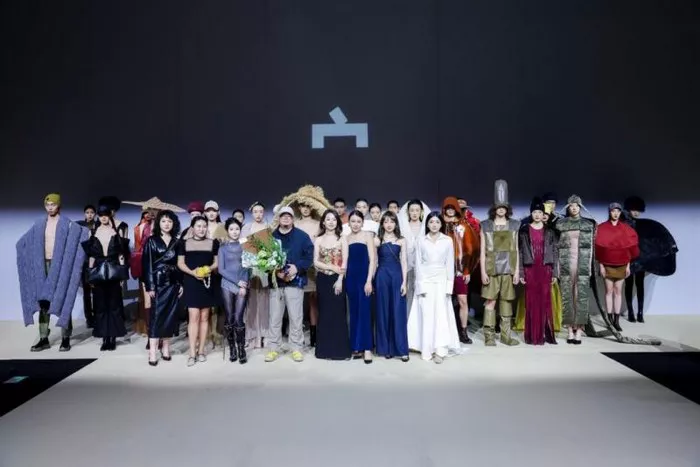On March 23, 2025, the Baoget “Registered” brand unveiled a remarkable cultural transformation at the China International Fashion Week. The event marked a stunning “rebirth” as the brand merged 3,600 years of architectural history with high fashion. Drawing inspiration from the “Baoget” character in oracle bone script—symbolizing eaves—this show reimagined the mechanical beauty of architectural bracket sets through innovative garment design. Tile patterns climbed up lapels, and the texture of ancient brick walls was intricately woven into flowing fabrics. The show was not merely a nod to intangible cultural heritage; it was a bold experiment in integrating culture into the very DNA of high fashion.
Baoget “Registered” went beyond traditional national style, creating a new, more profound path in fashion. By using the structural principles of architecture and the symbolic aesthetics of Chinese characters, the brand embedded culture within its framework, not just as surface decoration. The story of principal Sien Wang’s entrepreneurial journey began with a personal connection to the brand’s symbol. Having been bald for over a decade, Wang saw a hat as his “cultural armor,” and found that the “Baoget” character provided the ultimate answer in safeguarding it. His quest to create something uniquely cultural led him to delve into the “China Script Museum” in Anyang, Henan. There, he discovered that the “Baoget” character was not only a radical for 698 Chinese characters but also the precursor to Chinese architectural codes.
Baoget “Registered” emerged as a brand with a purpose: to be a “cultural architect,” not merely a transporter of symbols. Its mission was to bring ancient Chinese architectural principles into the world of fashion in a modern and innovative way.
Theme One: Independence – For the “Spiritual Nomads” of the City
The first theme showcased straight lines, broad shoulder silhouettes, and asymmetrical hems that echoed the cantilevered structure of bracket sets. The garments incorporated unbleached linen and hand-wrinkled cotton, preserving the mottled texture of natural dyes, symbolizing the shift from wilderness to civilization. The designer minimized gender symbols and employed a palette of gray and white tones, evoking a sense of tranquility and self-sufficiency. The minimalist silhouettes concealed magnetic modules, allowing hats to transform into scarves, while coats could be restructured into shawls through mortise and tenon fasteners. These designs symbolized the flexible survival strategies of modern urban dwellers.
Theme Two: Twin – A Romantic Game of Twin Structures
The second theme explored the interplay between dual layers of fabric. The outer layer, made of stiff ramie, functioned as armor, while the inner layer of translucent silk softly whispered beneath. The combined long dress featured independent cuts, and when placed side by side, the lapels overlapped to form the distinctive “Baoget” shape. Miniature bracket-shaped metallic pieces were embedded into the brim of the hat, concealing the Chinese character for “covering.” This design symbolized that love, like the interlocking parts of a structure, is not about dependency, but about the mechanical union of two independent souls.
Theme Three: Tranquility-Home – Portable Cultural Memory
The third theme used layers of earthy wool and indigo tie-dyed cotton stitched together. The lapels featured embroidered patterns from Lingyin Temple’s tiled designs, with each stitch made from metal wire melted from demolition waste. The show concluded with a dramatic three-meter-long cloak hat embossed with the texture of century-old brick walls from Hangzhou. As the model moved, the texture of the brick walls flowed, transforming into a modern interpretation of the famous “A Thousand Li of Rivers and Mountains” painting. This final piece embodied the warmth of “home,” deconstructed into a wearable and disassemblable cultural memory.
Baoget “Registered” – The Essence of Luxury
Sien Wang explained that Baoget “Registered” does not merely embed cultural symbols into its designs; it goes deeper, recalibrating architectural mechanics into the comfort of wearable fashion. The brand’s approach differs fundamentally from mainstream national style brands, which often use direct symbolism. Instead, Baoget “Registered” de-symbolizes designs, focusing on the deeper essence of Chinese culture.
The brand’s logo, “Baoget Registered,” has been reimagined into geometric, Mondrian-style lines and white spaces, embodying a Wabi-sabi aesthetic. The collection draws from ancient building materials like gray-white, ochre, and rust-red, shedding dynastic labels while maintaining the timeless texture of aged surfaces. Furthermore, Baoget “Registered” has created a closed-loop ecology by establishing a handmade workshop, the only one in the country that uses hat molds based on architectural bracket shapes. The brand collaborates directly with top fabric suppliers, such as Loro Piana and Piacenza, ensuring the highest standards of craftsmanship.
Baoget “Registered” is not just focused on the domestic market but has registered its trademark globally. The brand’s ambition extends beyond fashion shows to the creation of a cultural space near West Lake, where exhibitions of Chinese characters, traditional tea houses, and sustainable workshops will merge. Sien Wang expressed that the true essence of Eastern aesthetics lies in its quiet growth and cultural continuity. At the end of the show, as the last beam of light faded, guests left with more than a fleeting impression—they carried with them a wearable piece of history, a living transmission of culture.
Baoget “Registered” has proven that true cultural heritage can be reinterpreted in modern fashion, creating a legacy that speaks to the future while honoring the past.
Related Topics
- How to Achieve the Effortless Resort Style of The White Lotus Characters
- Top 10 Men’s Shoe Trends to Watch for in 2025
- Street Style Photographer Shares Behind-the-Scenes Moments from Fall/Winter 2025 Fashion Week

